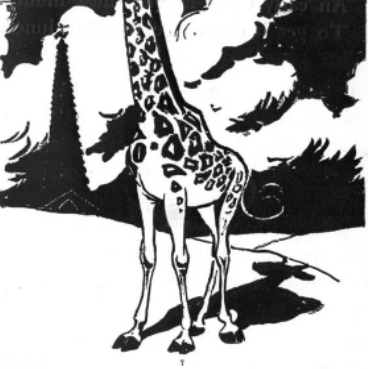The Giraffe
By Oliver Herford
Annotations by Karen Kilcup

See the Gi-raffe; he is so tall There is not room to get him all U-pon the page. His head is high-er— The pic-ture proves it—than the Spire.[1] That’s why the na-tives,[2] when they race To catch him, call it stee-ple-chase.[3] His chief de-light it is to set A good example: shine or wet He rises ere the break of day, And starts his break-fast right away. His food has such a way to go,— His throat’s so very long,—and so An early break-fast he must munch To get it down ere time for lunch.
Herford, Oliver. “The Giraffe.” A Child’s Primer of Natural History. New York: Charles Scribner’s Sons, 1899.
[1] Their steeples made churches the tallest buildings in most U.S. towns and many cities.
[2] Giraffes are native to the grasslands and open woodlands of Africa. See Contexts and Resources below for more detail.
[3] A steeplechase is a horse race across country with jumps and other obstacles, but Herford imagines the giraffe as a steeple.
Contexts
The late nineteenth century began the period known as The New Imperialism, in which Western European nations took control, and used the resources, of nearly the whole continent. This poem’s speaker distinguishes his European perspective by using the word “native.”
When Herford published his book, natural history was an obsessive subject for children’s writers. Popular magazines like St. Nicholas led the way, creating study groups like the St. Nicholas League and advocacy for bird protection through its Bird Defenders. Exotic animals seemed to particularly fascinate American children. Contributors to St. Nick included prominent scientists like William T. Hornaday, who became the director of the New York Zoological Park (commonly known as the Bronx Zoo), and who founded the National Zoo in Washington, DC; famous naturalist John Burroughs; and Ernest Thompson Seton, founder of the Boy Scouts of America.
Herford’s poems, as well as their accompanying images, presented more fanciful accounts of animals but sometimes offered small natural history lessons. In this case, Herford underscores the time it takes giraffes to swallow and digest food and water. All the poems in this book hyphenate some words, presumably to instruct children—and their parents—how to read.
Resources for Further Study
- “Giraffe, Giraffa camelopardalis.” San Diego Zoo Wildlife Alliance.
- “Giraffe Fact Sheet.” PBS Nature. July 15, 2020.
- Kilcup, Karen L. Stronger, Truer, Bolder: American Children’s Writing, Nature, and the Environment. Athens: University of Georgia Press, 2021. See chapter 4, esp. 271-74, for information about the St. Nicolas contributors mentioned above.
Contemporary Connections
The American Wildlife Foundation and The Nature Conservancy outline current challenges to giraffe habitat and proposes some solutions.
The National Geographic Society’s video “Giraffes 101” includes some surprising facts about the animal.